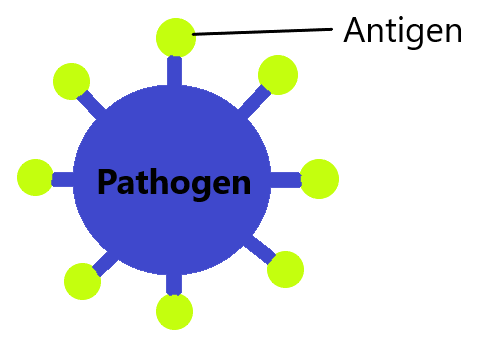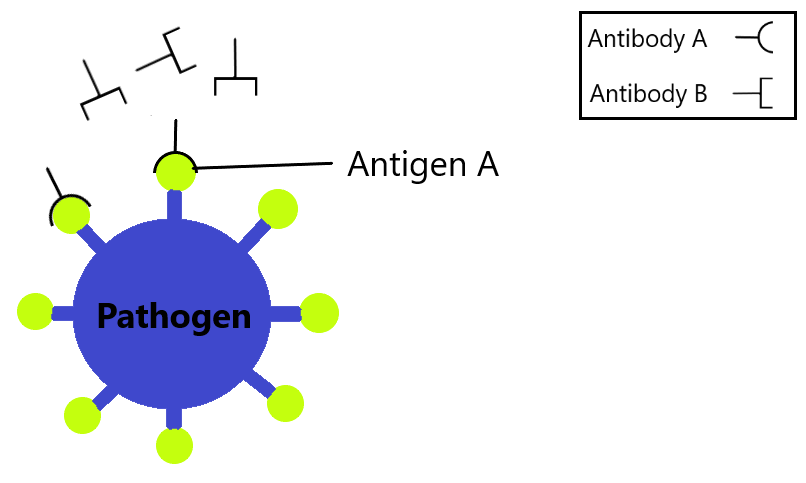Pathogen and disease
A pathogen is defined as a disease causing organism. Each pathogen has a uniquely shaped ‘marker’ on the surface of their membranes called antigens.

It is very important to understand that antigens are very specific in shape. Every pathogen is unique because they have differently shaped antigens on their cell surfaces!
A transmissible disease is a disease in which the pathogen can be passed from one host to another. The pathogen can be transmitted through direct contact (i.e. blood/body fluids) or indirect contact (i.e. contaminated food/air/animals/etc.)
Body defenses
In order to protect ourselves from pathogens and disease, our body has several protective mechanisms in place.
Mechanical barriers
Mechanical barriers act as a physical obstruction in order to prevent pathogens from entering our body. For example:
- Skin
- Nose hairs
Chemical barriers
Chemical barriers are chemical substances in the body which help to trap or destroy pathogens. For example:
- Mucus
- Traps bacteria that enters the respiratory system via air. The mucus is then beat upwards by the cilia and pushed up to the mouth.
- Stomach acid
- The acidity kills pathogens that enter our digestive system via the food we eat.
Cellular barriers
Cellular barriers are the protection offered by the cells of our immune system, which take part in combating against pathogens and disease. For example:
- Lymphocytes (which produce antibodies)
- Phagocytes
Antibodies and phagocytes will be covered in detail below
Cellular barriers
Phagocytosis
Phagocytosis is the mechanism by which phagocytes digest pathogens.
The steps of phagocytosis is as follows:
- Phagocyte extends itself and engulfs the pathogen
- Pathogen becomes trapped in a vesicle called phagosome
- Other vesicles containing digestive enzymes fuse with the phagosome
- Enzymes digest the pathogen

Antibodies
Function
Antibodies are proteins produced by cells called lymphocytes.
They bind to the antigens on pathogens and can either:
- Destroy the pathogen directly
OR - Alert phagocytes for destruction via phagocytosis
Remember, each pathogen has a uniquely shaped antigen on their cell surfaces. Therefore, for a particular antibody to aid the destruction of a certain pathogen, the shape of the antigen must be ‘fit’ or be ‘complementary’ to the shape of that particular antigen!
In the example below, only antibody A can ‘lock’ onto antigen A and therefore aid its destruction. Antibody B cannot due to the fact that it does not have a complementary shape to antigen A.

Production
Antibodies are produced by lymphocytes. Lymphocytes have receptors in their cell membranes that have a complementary shape to a certain antigen.
Lets consider lymphocyte A which have receptors that have a complementary shape to antigen A.
When a lymphocyte A comes across a pathogen with antigen A on its cell surface, their receptors can recognize the antigen and activate lymphocyte A.
The activated lymphocyte A then produces antibodies that have the same shape as their receptors, meaning that these antibodies can lock onto antigen A and destroy them.
Activated lymphocytes also produce memory cells, which are long-lived cells that remain in the blood even after the infection is over. They have the ability to rapidly produce the original antibodies if it were to come across the same pathogen/antigen again.

Vaccination
Vaccination is a treatment with a vaccine to evoke immunity to a certain antigen.
The vaccination process
The process of vaccination is as follows:
- A harmless variant on a certain antigen is introduced to the body i.e. via needle
- Immune response is triggered and activate lymphocytes produce antibodies and memory cells to fight against the antigen variant
- Therefore if the real antigen/pathogen eventually makes its way inside the body, there are pre-established antibodies/memory cells which can rapidly fight against it.
Controlling the spread of disease
Herd immunity is the idea that if most people of a population is immune to a disease, then the population becomes significantly resistant to the spread of that disease.
In other words, if majority of the population is immunized, it protects the people that are not.
Other consideration for controlling the spread of disease is as follows:
- Personal hygiene
- Food hygiene
- Waste disposal
- Sewage treatment
Passive immunity
Passive immunity is a short-term defense again a pathogen by antibodies transferred from one individual to another (rather than making their own).
For example, children benefit from the antibodies present in the mother’s breast milk.
Autoimmune disease
Some diseases are caused by the immune system targeting and destroying friendly body cells.
Type 1 diabetes is an example of an autoimmune disease whereby immune cells attack insulin producing beta cells in the pancreas.